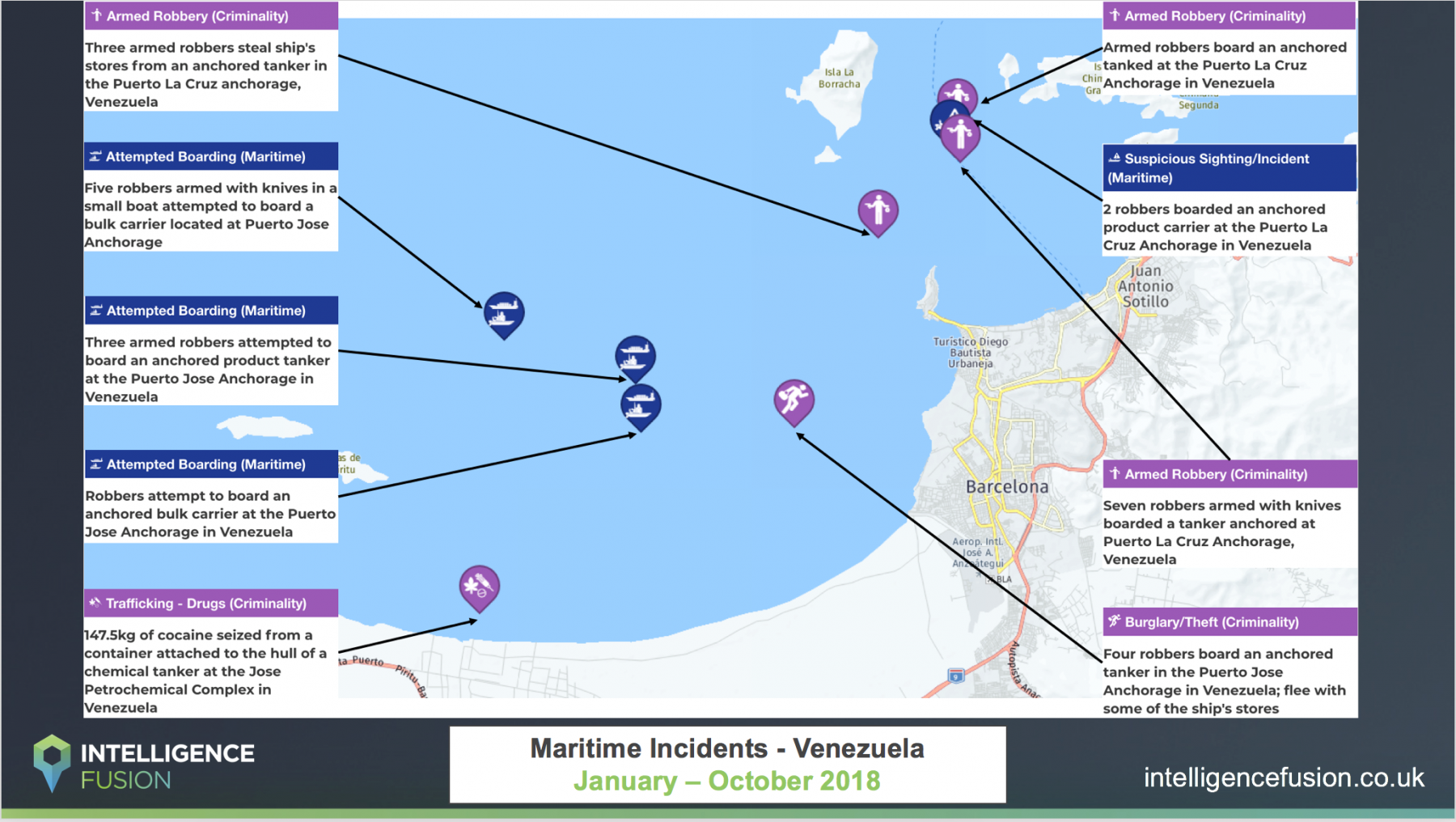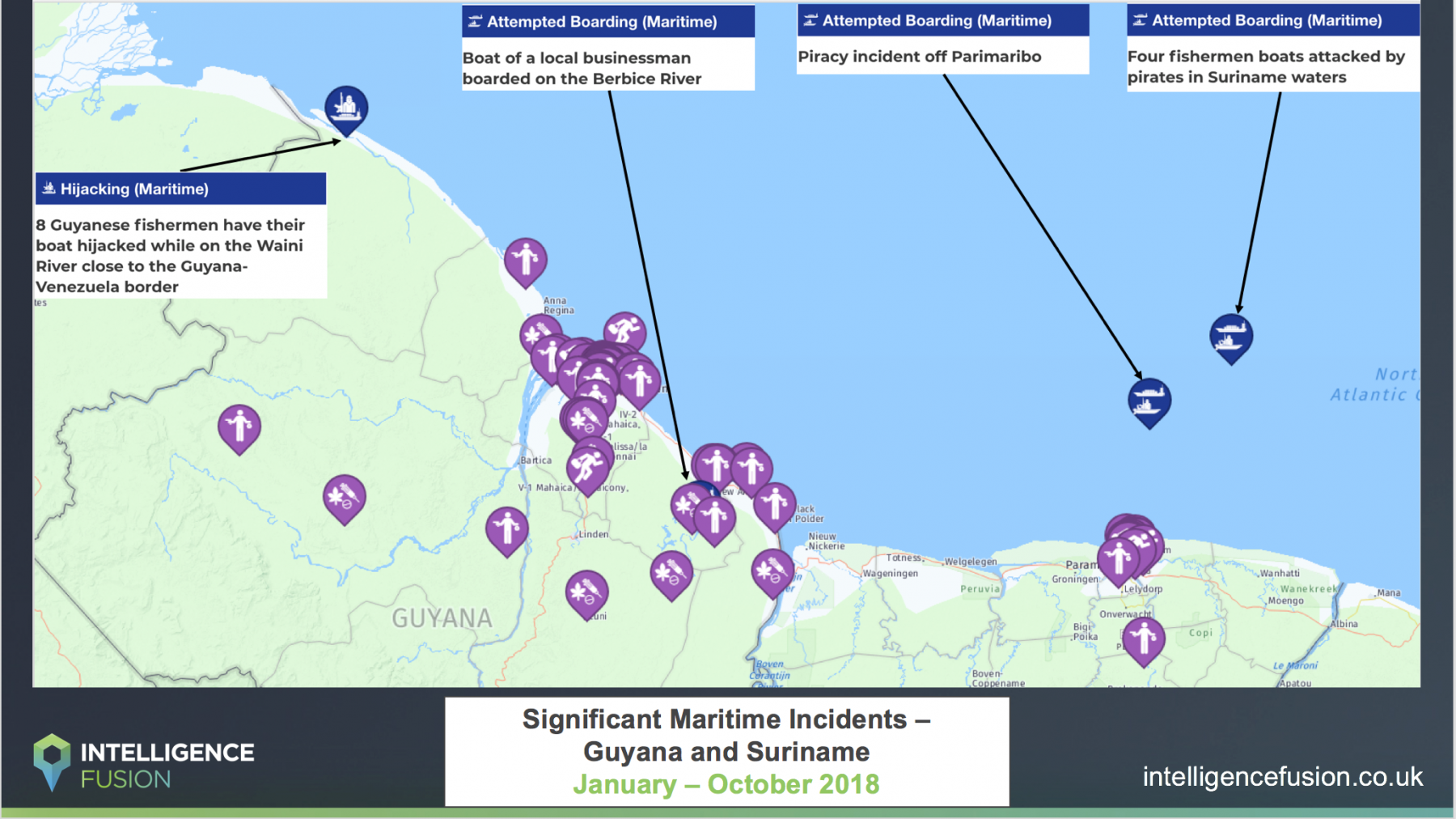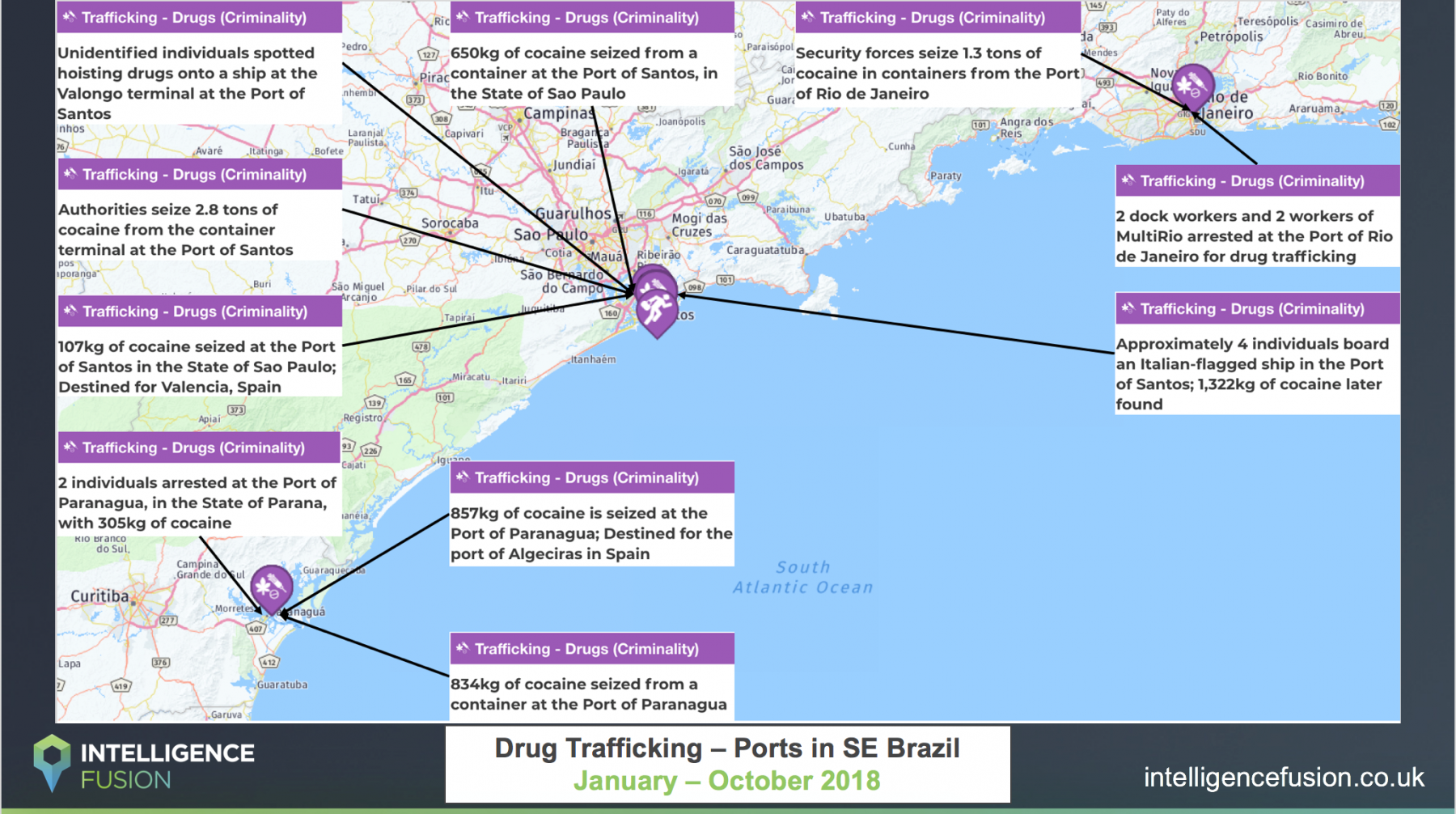Maritime Threats in South America: Piracy and Drug Trafficking
On October 4th, 2018, eight Guyanese fishermen were attacked and had their boat hijacked by a group of suspected Venezuelan nationals on the Waini River in Guyana on the border with Venezuela. The suspects forced the fishermen to jump overboard and then fled the scene with the hijacked vessel towards Venezuela. While no fishermen were injured, the incident is representative of the increase in maritime security incidents taking place around South America and the threat it poses to local fishermen and larger commercial vessels. A report published earlier this year by the Oceans Beyond Piracy non-profit organisation revealed a 163% increase in the number of piracy incidents recorded in South America and the Caribbean region between 2016 and 2017, with the trend not likely to decrease.
Intelligence Fusion has been monitoring maritime threats around South America in 2018, and in doing so has identified certain hotspots and trends. One such hotspot is off the coast of Venezuela. The area has seen a number of incidents over the course of 2018, particularly at the Puerto La Cruz and Puerto Jose Anchorages off the coast of Barcelona. Incidents have included boarding and attempted boarding of anchored container ships and tankers, in order to steal merchandise and property from the ships. During these attempts, the pirates or would-be pirates are often armed with knives. Piracy around the coast of Venezuela is said to have increased due to the economic troubles faced at home. Fishermen have seen a decline in the local fishing industry and have therefore turned to more lucrative activities such as drug trafficking and smuggling foodstuff and common household goods which are no longer found in the country. A recent World Economic Outlook report, published by the International Monetary Fund, estimates a lower economic growth for the continent than previously anticipated this year, and Venezuela fairs much worse than any other country. With no respite in the current Venezuelan economic situation, it is likely that the issue of piracy only worsens as more and more people look for other means of income. Parallels have been drawn with piracy in Venezuela and piracy in Somalia, particularly in the drivers of the problem.

A second hotspot of piracy related incidents is off the coast and on the rivers of Guyana and Suriname. The area was home to the most significant act of piracy in 2018 thus far in the region, in which four boats of Guyanese fishermen were attacked off the coast of Suriname. The fishermen were attacked with hot oil, machetes, and thrown overboard weighted with anchors. Five fishermen survived, three were killed and 12 remain missing. The attack was reportedly revenge for the death of the brother of one the suspects who has since been arrested, along with over a dozen individuals who participated in the attack. In addition to this attack, there have also been several incidents of boarding by robbers in order to steal motors, foodstuffs, and gasoline from private vessels.

Elsewhere in South America, similar incidents, but to a less violent extent, have been recorded particularly at the Macapa Anchorage in Brazil and the Callao Anchorage off Lima, Peru. More common threats to shipping companies elsewhere in South America is smuggling, particularly drugs. Drug traffickers will use the rip-off modality to move large quantities of drugs from countries in the region to others in North America, Europe, Africa, or Asia. The rip-off modality consists of drug traffickers hiding large quantities of drugs within legitimate shipments, primarily in containers, without the shipper or consignee being aware of the drugs being present. For this method to work, it often means that that drug traffickers have people they can trust embedded, or paid for, at the port of origin and port of destination in order to get the drugs in and out of containers without being noticed.
Incidents of police seizing drugs from containers at ports have primarily been recorded in Brazil, Ecuador, and Colombia. In Brazil, there have been several seizures of large shipments of cocaine being found on containers in the Port of Santos and Port of Paranagua in the southeast of the country. These containers were primarily destined for Antwerp, Belgium or Rotterdam, Netherlands, but have also included shipments towards other European countries and countries in Africa, like in Spain and Cote D’Ivoire. On 10th October the Federal Police conducted a security operation across the states of Rio de Janeiro, Paraiba and Rio Grande do Norte to dismantle a group of drug traffickers using the ports to move drugs to Europe. During the operation, several people were arrested, including two dock workers and two employees of MultiRio, a concessionaire at the Port of Rio de Janeiro. These arrests showcase how drug trafficking groups have individuals embedded in the ports to facilitate their operations.

Similar incidents have also been recorded in Ecuador, where the concentrations are at the Port of Guayaquil and in small ports off the northwestern province of Esmeraldas which borders Colombia where FARC dissidents and other paramilitary groups use drug trafficking as a means to fund their operations. Colombian drug trafficking also takes places at ports on its western and northern coasts, such as from the port of Cartagena. Cocaine from Colombia and Ecuador is primarily moved to Central American and Caribbean countries on its way to the North American market, with some shipments heading to Europe.
Security Implications
Every year, ships carry hundreds of millions of containers, transporting close to 90% of the world’s goods. This allows ample opportunities for criminal groups to move illicit goods, particularly drugs and weapons, hidden in legal shipments to destinations across the globe. This has been seen through the seizure of large quantities of drugs at ports across Latin America, as well as several incidents of weapons trafficking including the seizure of 60 assault rifles from a container at the port of Montevideo, Uruguay in August. These activities along with piracy pose a variety of threats to shipping companies whether at sea or in ports. The activities of traffickers and pirates pose both reputational and security risks to these companies. Reputations are put at play when containers loaded with their legal merchandise are used by drug traffickers to move their drugs without their knowledge. As containers are searched and seized, it puts the owners of the legal goods inside the containers, the shipping company, and the port operators at risk of being associated with the movement of contraband. Additionally, the use of legitimate cargo loads as a means for drug traffickers to move their product to other countries puts shipping companies and their employees at risk of extortion from the criminal groups themselves, or by corrupt port officials being paid by these criminal groups. Any involvement in such corruption may put shipping companies’ reputations at risk.
Physical security risks primarily stem from pirates operating in the local and regional waters, as well as from drug traffickers looking to protect their shipments. Piracy incidents mentioned earlier showcase the physical risks posed whether it be hijackings of small vessels, or from armed robbers threatening crews of the anchored ships they board at anchorages around the region. In 2018, incidents of attacks on fishermen or container ships have primarily been observed off Venezuela, Guyana, Suriname, and with a few incidents off Peru and Ecuador. Drug traffickers protecting their shipments also pose risks to port operators and crews of container ships, as was showcased in an incident off the coast of Cartagena, Colombia in late January. In that incident, a group of 10 armed men, were arrested onboard a German container ship heading to the Dominican Republic, as they were protecting 185kg of cocaine. While the crew was not harmed in the incident, the threat of violence posed by heavily armed men guarding such shipments is high.
The United Nation’s Office on Drugs and Crime has said that cocaine production rose by over 30% in Colombia between 2016 and 2017. With Colombia, Bolivia, and Peru continuing to produce large quantities of the drugs, criminal groups will continue to seek access to shipping routes to their markets across the world. This will continue to put shipping companies and port operators at risk of physical and reputational risks. Additionally, the continuing economic situation and outlook in Venezuela will continue and may increase the number of incidents involving armed robbers boarding or attempting to board container ships to steal merchandise, putting the crews of those ships at risk of face-to-face encounters with these robbers. While the bulk of maritime security related incidents continue to be concentrated in the Gulf of Guinea and in southeast Asia, the threat has increased over the last several years in Latin America and the Caribbean region and must be closely watched. Further areas for Intelligence Fusion to explore:
- The role of the economic crisis in Venezuela on piracy incidents off its coast
- Looking at the maritime smuggling of other products such as oil
- Looking at the maritime threats presents in Central America and the Caribbean
- Looking at other threats present to the maritime infrastructure of Latin America
- Theft from oil and gas maritime platforms in the Gulf of Mexico

